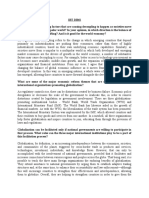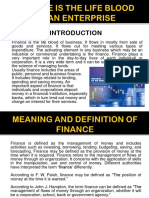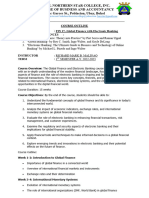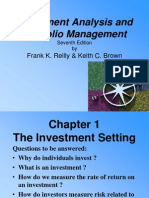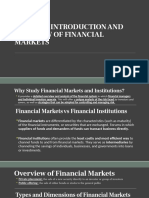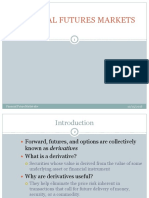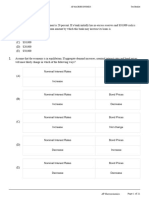Module Financial Institution
Module Financial Institution
Uploaded by
Zeeshan NazirCopyright:
Available Formats
Module Financial Institution
Module Financial Institution
Uploaded by
Zeeshan NazirOriginal Description:
Copyright
Available Formats
Share this document
Did you find this document useful?
Is this content inappropriate?
Copyright:
Available Formats
Module Financial Institution
Module Financial Institution
Uploaded by
Zeeshan NazirCopyright:
Available Formats
Chapter 1 Introduction of Financial Markets
Financial Markets
Financial Markets are an important part of the financial system as they promote economic efficiency by channeling the funds from savers to investors. They provide the platform where people who dont have productive use of funds, can meet with the people who have some ideas for the productive use of the funds. So its important to study financial markets because they also have effect on the personal wealth and businesses which affects the overall performance o f economy.
Types of Financial Markets
Debt Market The debt market also referred to as bond market is a financial market where participants can issue new debt, known as the primary market, or buy and sell debt securities, known as the secondary market. This is usually in the form of bonds, but it may include notes, bills etc. Security is basically a claim on the assets or income of the issuer of the debt security. The bond has periodic payments for the specified periods of time. The interest rates are important as they can affect our lending or borrowing decisions. High interest rates may restrain us to borrow. Conversely, if interest rates are low we may not be willing to lend or issue the security. Stock Market The market where shares of stocks are traded or we can say that where common stock is issued is known as stock market and it is the most widely followed financial market. It is also called equity market. A common stock (typically just called a stock) represents a share of ownership in a corporation. The stock market is also an important factor in business investment decisions, because the price of shares affects the amount of funds that can be raised by selling newly issued stock to finance investment spending. A higher price for a firms shares means that it can raise a larger amount of funds, which can be used to buy production facilities and equipment. Foreign Exchange Market As trade and financial transactions are occurred between the countries too, we need foreign exchange markets where the conversion of the currency takes place. Currency conversion is important in moving funds from one country to another. For currency conversion, foreign exchange rate is required which is determined in this market. Foreign exchange rate is the price of one currency in terms of the other. The fluctuations in foreign exchange rate effects the businesses and economies of countries. For example, if PKR appreciates against dollar, it will effective our exports and may leads to current account deficit. Such types of effects force us to study and consider the exchange rates in international trade. Activities in financial markets have direct effects on individuals wealth, the behavior of businesses, and the efficiency of our economy. Three financial markets deserve particular attention: the bond market
where interest rates are determined, the stock market which has a major effect on peoples wealth and on firms investment decisions, and the foreign exchange markets.
Financial Institutions
Financial institutions are what make financial markets work. Without them, financial markets would not be able to move funds from people who save to people who have productive investment opportunities. They thus play a crucial role in improving the efficiency of the economy. Structure of Financial System The financial system is compromised of financial institutions which are also called financial intermediaries. These financial institutions include banks, insurance companies, mutual funds, finance companies, and investment banks etc. These intermediaries serve by finding the buyers and sellers for the securities. They borrow funds from people who have saved and in turn make loans to others. Financial Crises
The term financial crisis is applied broadly to a variety of situations in which some financial assets suddenly lose a large part of their nominal value. Many financial crises were associated with banking panics, and many recessions coincided with these panics. Other situations that are often called financial crises include stock market crashes and the bursting of other financial bubbles, currency crises, and sovereign defaults. Financial crises directly result in a loss of paper wealth but do not necessarily result in changes in the real economy. Central Banks and the Conduct of Monetary Policy The central bank is the government agency which conducts the monetary policy and is important among all of the financial institutions. The central bank of US is Federal Reserves system. Monetary policy involves the management of interest rates and the quantity of money. Because monetary policy affects interest rates, inflation, and business cycles, all of which have a major impact on financial markets and institutions. Current functions of the Federal Reserve System include. To address the problem of banking panics To serve as the central bank for the United States To strike a balance between private interests of banks and the centralized responsibility of government To supervise and regulate banking institutions
Because monetary policy affects interest rates, inflation, and business cycles, all of which have an important impact on financial markets and institutions, we need to understand how monetary policy is conducted by central banks.
The International Financial System The growing transactions and international trade among countries have led to rise of international financial system where exchange rates and other relating effects on domestic economies are checked.
Bank and Other Financial Institutions Banks are the largest financial intermediaries and with which almost every one of us interacts more frequently. Banks are financial institutions that accept deposits and make loans. Included under the term banks are firms such as commercial banks, savings and loan associations, mutual savings banks, and credit unions. A person who needs a loan to buy a house or a car usually obtains it from a local bank. Other financial institutions such as insurance companies, finance companies, pension funds, mutual funds, and investment banks have been growing. In short, Banks and other financial institutions channel funds from people who might not put them to productive use to people who can do so and thus play a crucial role in improving the efficiency of the economy. Financial Innovation Financial innovation is to bring the new forms of issuing stocks and to raise money. It also includes improving the financial transactions b/w businesses and individuals. E.g. the ATM was a financial innovation as it was new way to make transactions. Financial innovation is very important as people prefer some securities over others. Managing Risk in Financial Institutions Due to international trade, the economic environment has become an increasingly risky place. Interest rates have fluctuated wildly, stock markets have crashed in every part of the world, speculative crises have occurred in the foreign exchange markets, and failures of financial institutions have reached levels unprecedented since the Great Depression. So financial institutions should take the responsibility to settle the financial system and must be concerned with the risks inherent in the inefficient international transactions.
Conclusions
Financial markets are integral part of the financial system. If the financial markets of any country are derailed or lack capabilities, the economic bubbles may arise which creates financial panic ultimately leading to the financial crises. Central banks are made by the Governments to maintain the efficient running of financial markets and system to avoid the financial panics and economic bubbles. Banks can play vital role by maintaining the liquidity of the markets.
Financial innovations are very important with the passage of time as efficient and speedy transactions are need of todays changing environment and the issues and risk associated with the issuing stock and debt may also required that financial innovation should be supported.
Assignments
Chapter 2 Overview of Financial System
Function of Financial Markets
Financial markets perform the economic function of channeling funds from households, firms, and governments that have saved surplus funds by spending less than their income to those that have a shortage of funds because they wish to spend more than their income. The principal savers are households, but business enterprises and the government, as well as foreigners and their governments, sometimes also find themselves with excess funds and so lend the funds. The most important borrowers are businesses and the government, but households and foreigners also borrow to finance their purchases. There are two methods by which funds can be transfer from lenders to borrowers.
Direct Finance:
In direct finance borrowers get the funds directly from the lenders in the financial markets by selling them the securities in the form of financial instruments. The security is the claim on the borrowers future income or assets. On the other hand the security is liability for the borrower. The financial instruments can be bonds or issuing of the shares. The bonds pay periodic payments to the lenders for the specified periods of time while common stock shares gives the lenders actual ownership on the assets financed with the funds given by him/her. Financial markets are critical for producing an efficient allocation of capital which contributes to higher production and efficiency for the overall economy. The allocation of capital is both in the form of Physical assets and in Financial assets. Well-functioning financial markets also directly improve the wellbeing of consumers by allowing them to time their purchases better. Financial markets that are operating efficiently improve the economic welfare of everyone in the society as they allow the buyers and sellers of the securities, a platform to interact with each other. Structure of Financial Markets: Financial markets are categorized into several different forms with each having essential features. They are listed below. Debt and Equity Markets
A firm or an individual can obtain funds in a financial market in two ways. The most common method is to issue a debt instrument, such as a bond which is a contractual agreement by the borrower to pay the holder of the instrument fixed amount of money at regular intervals until a maturity date, when a final payment is made. This type of market is called Debt or Bond market. Bonds are long term instruments. Debt instruments having the maturity period less than one year are short term debt instruments. The 2nd method to obtain funds is by issuing equities, such as common stock, which are claims to share in the income and the assets of a business. The market for this type of securities is called Equity or Common stock market. Equities often make periodic payments which are called dividends to their holders and are considered long-term securities because they have no maturity date. Owning stock means that you own a portion in the business of the borrower and the shares gives you the right to vote to elect the board of directors. The dividends to the common stock holders are paid if the debt holders are paid with their interest. Otherwise common stock holders may not get their dividends. Primary and Secondary Markets A primary market is a financial market in which new issues of a security, such as a bond or a stock. While a secondary market is a financial market in which securities that have been previously issued can be resold. Public mostly knows about the secondary market because selling of the securities in primary markets is done behind the camera. A large financial institution buys the securities by underwriting those securities. The process of issuing new securities is mostly done by IPOS. The Secondary market transactions carried out between public gives no monetary value to the firm. But secondary market is important as it provides liquidity. Also the price of new securities to issue is determined by the secondary market. If demand in the secondary market is more of the firms securities, financial institution purchasing the securities will have to pay the larger price for the new securities to firm. Exchanges and Over-the-Counter Markets Secondary market includes two more markets in it, the Stock Exchanges and Over the Counter Market. In exchanges, buyers and sellers of securities meet in one central location to conduct trades i.e. Karachi and Islamabad stock exchanges. In over-the counter (OTC) market, in which dealers at different locations who have an inventory of securities stand ready to buy and sell securities over the counter to anyone who comes to them and is willing to accept their prices. This is an online market where buyers and sellers contact each other online. Many stocks are traded in the OTC market but largely are traded in the Stock exchanges. Money and Capital Markets The money market is a financial market in which only short-term debt instruments are traded; the capital market is the market in which longer term debt and equity both instruments are traded. Money market securities are usually more widely traded than longer-term securities because they are more liquid. Capital market securities, such as stocks and long-term bonds, are often held by financial intermediaries such as insurance companies and pension funds.
Internationalization of Financial Markets
The deregulation of Trade laws and Globalization has led to the internationalization of financial markets. Following international bonds and stock markets have emerged due to this globalization. International Bond Market, Eurobonds, and Eurocurrencies The international bond market contains the following instruments. Foreign Bond: The bond sold in a foreign country but denominated in that Countrys currency. Eurobond: The bond denominated in a currency other than that of the country in which it is sold. Eurocurrencies: These are foreign currencies deposited in banks outside the home country. The most important of the Eurocurrencies are Eurodollars, which are U.S. dollars deposited in foreign banks outside the United States or in foreign branches of U.S. banks. World Stock Markets Along with the USA stock markets, several other countries market have also emerged as powerful stock markets i.e. Japans and Britain. So, investors try to invest in those markets also. That is why investors now pay attention not only to the Dow Jones Industrial Average but also to stock price indexes for foreign stock markets such as the Nikkei 300 Average (Tokyo) and the Financial Times Stock Exchange (FTSE) 100-Share Index (London).
Indirect Finance
The 2nd way to transfer funds from lenders to borrowers is by incorporating the financial intermediary in between. This is why this method is called indirect finance. A financial intermediary performs its duty by borrowing funds from the lender-savers and then using these funds to make loans to borrowers. This method of financial intermediation is primary route for moving the funds. The following are the reasons why this is primary source of transferring funds. Transaction Costs: The time and money spent in carrying out financial transactions are a major problem for people who have excess funds to lend. Financial intermediaries can substantially reduce transaction costs because they have developed expertise in lowering them and because their large size allows them to take advantage of economies of scale. So they also provide its customers with liquidity services, services that make it easier for customers to conduct transactions. Risk Sharing The financial intermediaries can reduce the risk and uncertainty of the investors about their returns. They create and sell assets with risk characteristics that people are comfortable with, and the intermediaries then use the funds they acquire by selling these assets to purchase other assets that may have far more risk.
Asymmetric Information: Adverse Selection and Moral Hazard One party often does not know enough about the other party to make accurate decisions. This inequality is called asymmetric information. Adverse selection is the problem created by asymmetric information before the transaction occurs. The bad creditors may be selected by the lenders. Because adverse selection makes it more likely that loans might be made to bad credit risks, lenders may decide not to make any loans even though there are good credit risks in the marketplace. Moral hazard is the problem created by asymmetric information after the transaction occurs. This means that the borrower may indulge in the activities that may be not good according to the lenders point of view. With financial intermediaries in the economy, small savers can provide their funds to the financial markets by lending these funds to a trustworthy intermediary.
Types of Financial Intermediaries
The financial intermediaries fall into three main types, depository institutions, contractual savings institutions, and investment intermediaries. Depository institutions are financial intermediaries that accept deposits from individuals and institutions and make loans. These institutions include commercial banks, savings and loan associations, mutual savings banks, and credit unions. Contractual savings institutions, such as insurance companies and pension funds, are financial intermediaries that acquire funds at periodic intervals on a contractual basis. Investment intermediaries include finance companies, mutual funds, and money market mutual funds.
Regulation of Financial System
Governments regulate the financial system of their country due to following reasons: Increasing Information Available to Investors: The asymmetric information hinders the efficiency of financial markets. Government regulation can reduce adverse selection and moral hazard problems in financial markets and increase their efficiency by increasing the amount of information available to investors. Ensuring the Soundness of Financial Intermediaries: Asymmetric information can lead to collapse of financial system as it hinders the efficient working of the financial intermediaries. This may create financial panic and leads to economic bubbles in the economy. To protect the public and the economy from financial panics, the government can implement several types of regulations. Restrictions on Entry: who is allowed to set up financial intermediary and who are not eligible? Disclosure: stringent rules for intermediaries for reporting Restrictions on Assets and Activities: There are restrictions on what financial intermediaries are allowed to do and what assets they can hold. Deposit Insurance: Government can insure people deposits Limits on Competition: unnecessary competition among intermediaries should be disallowed.
Restrictions on Interest Rates: impose restrictions on interest rates that can be paid on deposits.
Conclusions
The International trade and business is so much evolved in the recent decade that now without it the world may not be able to sustain. For this purpose the need for foreign exchange transactions to be successfully carried foreign exchanges and markets are required. Now, stock markets and Debt markets are internationally involved in the currency exchange transactions. Role of financial markets as already discussed is vital. Along with them, financial intermediaries cannot be ignored because they are integral part of the financial markets and financial system. People and firms can undertake their borrowing and lending directly in the financial markets or indirectly by putting in the intermediary which can facilitate the transaction.
Assignments Financial Crises
The term financial crisis is applied broadly to a variety of situations in which some financial assets suddenly lose a large part of their nominal value. Many financial crises were associated with banking panics, and many recessions coincided with these panics. Other situations that are often called financial crises include stock market crashes and the bursting of other financial bubbles, currency crises, and sovereign defaults. Financial crises directly result in a loss of paper wealth but do not necessarily result in changes in the real economy.
Types of Financial Crises
Currency Crises A currency crisis involves a speculative attack on the currency resulting in a devaluation (or sharp depreciation), or forcing the authorities to defend the currency by expending large amount of international reserves, or sharply raising interest rates, or imposing capital controls. Sudden Stop A sudden stop (or a capital account or balance of payments crisis) can be defined as a large (and often unexpected) fall in international capital inflows or a sharp reversal in aggregate capital flows to a country, likely taking place in conjunction with a sharp rise in its credit spreads. Foreign and Domestic Debt Crises A foreign debt crisis takes place when a country cannot or does not want to service its foreign debt. It can take the form of a sovereign or private (or both) debt crisis. A domestic public debt crisis takes place when a country does not honor its domestic fiscal obligations in real terms, either by defaulting explicitly,
or by inflating or otherwise debasing its currency, or by employing some other forms of financial repression. Banking Crises A systemic banking crisis, actual or potential bank runs and failures can induce banks to suspend the convertibility of their liabilities or compel the government to intervene to prevent this by extending liquidity and capital assistance on a large scale.
Since the first two are measurable variables, they lend themselves to the use of quantitative methodologies while the later are not so easily measurable variables, they lend themselves more to the use of qualitative methodologies.
Financial Crises of 1987
The financial crises of 1987 was not just due to decline in the stock prices but it was due to the weaknesses of financial and trading system implemented at the time. The capacity of the system to transact so many transactions was also a major reason behind the crises. The down fall of prices and collapse of system was due to following reasons. The main cause of crises was program strategies. There were two types of program strategies enforced at the time, Portfolio insurance and Arbitrage index. Portfolio insurance led all the investors to sell their stocks but there were no buyers to maintain liquidity. So the arbitrage factor was not available. Hence liquidity suffered which led to downfall of the stock prices. Secondly, there was uncertainty and lack of information due to rapidly changing environment. Stock price index was not really reliable which raised confusion among the investors and the wanted to sell the stock to portfolio insurers. The third factor was margin calls, at the end of every day of the crises week, there were so many transactions than routine due to falling prices because of margin calls. The clearing house was not able to clear and process so many transactions with ease and efficiency. Hence this entire scenario led to reduction in the liquidity of the securities and stocks, which causes the financial and trading system to collapse. While when this scenario happened, the Federal Reserve took some steps to run the system. Due to actions of Federal Reserve, the situation became pretty much in control. The major step was to encourage the Financial Institutions especially banks, to maintain liquidity level, have lower credit terms and flexibility in rules and regulations should be provided to the public for the efficient running of the system.
Financial Crises of 1997
The Asian financial crisis was a period of financial crisis that gripped much of East Asia beginning in July 1997, and raised fears of a worldwide economic meltdown due to financial contagion. The Asian financial crisis involves four basic problems or issues: (1) a shortage of foreign exchange that has caused the value of currencies and equities in Thailand, Indonesia, South Korea and other Asian countries to fall dramatically, (2) Inadequately developed financial sectors and mechanisms for allocating capital in the troubled Asian economies, (3) Effects of the crisis on both the United States and the world, and (4) The role, operations, and replenishment of funds of the International Monetary Fund. The Asian financial crisis was initiated by two rounds of currency depreciation that have been occurring since early summer 1997. The first round was a precipitous drop in the value of the Thai baht, Malaysian ringgit, Philippine peso, and Indonesian rupiah. As these currencies stabilized, the second round began with downward pressures hitting the Taiwan dollar, South Korean won, Brazilian real, Singaporean dollar, and Hong Kong dollar. Governments have countered the weakness in their currencies by selling foreign exchange reserves and raising interest rates, which, in turn, have slowed economic growth and have made interest-bearing securities more attractive than equities. The currency crises also has revealed severe problems in the banking and financial sectors of the troubled Asian economies. The two main hypothesis and interpretations have been emerged in the aftermaths of the crises. According to one view, the sudden shifts in the market expectations and confidence were the key sources of the initial financial turmoil, its propagation overtime and regional contagion. While the macroeconomics conditions of some countries had worsened in the mid 1990s, the extent and depth of the 1997-98 crises should not be attributed to deterioration in fundamentals, but rather to panic on the part of domestic and international investors, somewhat reinforced by the faulty policy response of IMF and International Finance community.
Euro Currency assignment
Currency Convertibility
Quality that allows one currency to be converted into another currency is known as currency convertibility. It determines the ability of an individual, corporation or govt. to convert its local
currency with or without central bank or govt. intervention. Currency convertibility is important in international trade where instruments in different currencies must be exchanged. Conversion Features Full convertibility: No limitations on the amount to be converted. Govt. does not impose any fix value to be converted. E.g. Dollar is fully convertible currency Partially convertible: Central banks controls international investments inflow and outflow. Significant restrictions are there for this type of currency on international investments. E.g. PKR Non Convertible: Neither participates in international market. It is Non convertible and blocked currency. E.g. North Korean Won and Cuban Peso
Euro Dollar Market
US dollars deposits outside USA are called Euro dollars. These are not under the jurisdiction of Federal Reserve System and subject to less regulations than with in the USA. After the WW 2, $ increased enormously outside of USA due to imports. This resulted in USA dollars in custody of foreign banks. Various Myths Communist China: Transferred their dollar deposits to France in Soviet Union bank due to America-Korea cold relations in 1949 Soviet Union: Moved their dollar deposits during the cold war period after invasion of Hungry. They were having perceptions that America may cease their dollar deposits in America. Soviet Union wanted more interest rates on their Euro Dollars. They convinced an Italian bank because they could earn more interest than in USA. Thus Eurodollars began to use increasingly in global finance. Eurodollars contains the features such as Derivative contracts, future contracts and sweeps.
Birth of European Community
EEC was established under the treaty of Rome which was created by six European countries. Aims: Free movement of labor and Capital Abolition of Trusts and Cartels Development of Joint and Reciprocal policies on labor Social welfare Agriculture improvements Transport and Foreign Trade
Accomplishments Common price levels for the Agricultural products Internal Tariffs eliminated Lead to revised national laws and regulations Established common market and Economic Integration
International Debt Market
This is the market where securities and interest on securities are delivered in exchange of payment of money. Settlement date is established 3 days before trade for marketable stock. For listed options and Govt. securities this date is usually one day before. Risks are there for both parties which is managed by the process of clearing. This process involves modifying contractual obligations to facilitate settlement. There are two types of settlements in the market, Physical and Electronic. Physical movement of documents and payments are made by checks in the physical method. There is higher risk associated with this type of method as due to theft or any other loss. While in Electronic method there is no need to move the documents physically. It does simultaneous delivery of securities with payment. Hence overall market participants are protected from risk of default by this market.
You might also like
- Oliver Branchard, 8th Ed PDFDocument18 pagesOliver Branchard, 8th Ed PDFYan Yan Myo Naing20% (10)
- Asset Allocation 5E (PB): Balancing Financial Risk, Fifth EditionFrom EverandAsset Allocation 5E (PB): Balancing Financial Risk, Fifth EditionRating: 4 out of 5 stars4/5 (13)
- MCQ Booklet-IedDocument60 pagesMCQ Booklet-IedSuchi SinghNo ratings yet
- Impact of Monetary Policy On Indian EconomyDocument15 pagesImpact of Monetary Policy On Indian EconomyKiran YadavNo ratings yet
- Financial AssetDocument14 pagesFinancial AssetkhushboogeetaNo ratings yet
- Chapter:-1 Introduction To BankDocument55 pagesChapter:-1 Introduction To BankLaxman ZaggeNo ratings yet
- Case Study - Financial MarketsDocument9 pagesCase Study - Financial Marketsbtsvt1307 phNo ratings yet
- Unit Ii: Conventional Finance, Prospect Theory and Market EfficiencyDocument27 pagesUnit Ii: Conventional Finance, Prospect Theory and Market EfficiencyKathleen De JoseNo ratings yet
- Monetary Policy and CB Module-4Document11 pagesMonetary Policy and CB Module-4Eleine AlvarezNo ratings yet
- Golden Rules - Credit ManagersDocument2 pagesGolden Rules - Credit ManagersDeepalaxmi Bhat100% (1)
- FINMAN NotesDocument11 pagesFINMAN NotesIris FenelleNo ratings yet
- Financial MarketsDocument83 pagesFinancial MarketsKriz BizNo ratings yet
- Inventories With Lower Cost, Without Sacrificing Its QualityDocument4 pagesInventories With Lower Cost, Without Sacrificing Its QualityMark Lyndon YmataNo ratings yet
- Financial Institution and MarketDocument52 pagesFinancial Institution and Marketsabit hussenNo ratings yet
- Ibt DB2Document3 pagesIbt DB2Ian TamondongNo ratings yet
- Difficulties Experienced by The Street VendorsDocument3 pagesDifficulties Experienced by The Street Vendorsyeunwoo alquizarNo ratings yet
- 19 - Interest Rate and Its Role in FinanceDocument18 pages19 - Interest Rate and Its Role in FinanceRydel CuachonNo ratings yet
- Challenges Faced by CooperativesDocument3 pagesChallenges Faced by CooperativesRaul Ang InocandoNo ratings yet
- Finance Is The Life Blood of An EnterpriseDocument7 pagesFinance Is The Life Blood of An EnterpriseAngel EkkaNo ratings yet
- Chapter 2Document5 pagesChapter 2Sundaramani SaranNo ratings yet
- Chapter 1: Overview of Government AccountingDocument12 pagesChapter 1: Overview of Government AccountingmengistuNo ratings yet
- Forms of Business OwnershipDocument45 pagesForms of Business OwnershipAllan BacudioNo ratings yet
- MODULE-1 Global FinanceDocument7 pagesMODULE-1 Global FinanceDhiann AlboresNo ratings yet
- Managerial EconomicsDocument7 pagesManagerial EconomicsRam SoniNo ratings yet
- Module 2 - PRACTICING ENTREPRENEURSHIPDocument15 pagesModule 2 - PRACTICING ENTREPRENEURSHIPTrixy Fauna LuminarioNo ratings yet
- Financial Markets and InstitutionsDocument78 pagesFinancial Markets and Institutionsamol_more37100% (1)
- Chapter 2-Market and Market SegmentationDocument25 pagesChapter 2-Market and Market SegmentationMA ValdezNo ratings yet
- Financial Management - Chapter 9Document17 pagesFinancial Management - Chapter 9mechidreamNo ratings yet
- Goals and Functions of Financial ManagementDocument30 pagesGoals and Functions of Financial ManagementskNo ratings yet
- Financial Controllership: Presented byDocument19 pagesFinancial Controllership: Presented byEloisa MonatoNo ratings yet
- Financial ForecastingDocument8 pagesFinancial ForecastingbenNo ratings yet
- Financial Institutions Ch-1Document28 pagesFinancial Institutions Ch-1Shimelis Tesema100% (2)
- Unit 1 Introduction To BankingDocument27 pagesUnit 1 Introduction To BankingRandom HeroNo ratings yet
- Finman Chapter 7 SummaryDocument2 pagesFinman Chapter 7 SummaryJoyce Anne Gevero CarreraNo ratings yet
- Financial Market Part 1 PDFDocument23 pagesFinancial Market Part 1 PDFsanjayifm100% (1)
- International FinanceDocument1 pageInternational FinanceShivarajkumar JayaprakashNo ratings yet
- "The Global Business Environment Is REALLY CHANGING!": BME 30 BME 30 International Business and TradeDocument11 pages"The Global Business Environment Is REALLY CHANGING!": BME 30 BME 30 International Business and TradeGeorizz Kristine Escaño100% (1)
- Module I Basic AccountingDocument11 pagesModule I Basic Accountingpaul amo100% (1)
- BF401 Introduction To TreasuryDocument24 pagesBF401 Introduction To Treasurytafadzwa laison100% (1)
- Investment Analysis and Portfolio Management: Frank K. Reilly & Keith C. BrownDocument42 pagesInvestment Analysis and Portfolio Management: Frank K. Reilly & Keith C. BrownRaja GoharNo ratings yet
- Chapter 1 - The Nature of Strategic ManagementDocument70 pagesChapter 1 - The Nature of Strategic ManagementabmyonisNo ratings yet
- Interest Rates and Their Role in FinanceDocument17 pagesInterest Rates and Their Role in FinanceClyden Jaile RamirezNo ratings yet
- Financial IntermediaryDocument10 pagesFinancial Intermediaryalajar opticalNo ratings yet
- Financial Forecasting: Mcgraw-Hill/IrwinDocument39 pagesFinancial Forecasting: Mcgraw-Hill/IrwinAllaine Vera MercadoNo ratings yet
- Chapter 4 - Securities Markets & OrganizationsDocument28 pagesChapter 4 - Securities Markets & OrganizationsImejah FaviNo ratings yet
- Chapter 6 - Bond ValuationDocument46 pagesChapter 6 - Bond ValuationHarith DaniealNo ratings yet
- Chapter 2 - Overview of The Financial System PDFDocument20 pagesChapter 2 - Overview of The Financial System PDFAngel SisonNo ratings yet
- Capital MarketDocument12 pagesCapital MarketDonna MarcialNo ratings yet
- Financial Markets - Chapter 1 PDFDocument19 pagesFinancial Markets - Chapter 1 PDFBuzon Kyle BluNo ratings yet
- Chapter 1 - PPT - 2Document27 pagesChapter 1 - PPT - 2Maryam Ali100% (1)
- Consumption, Savings and InvestmentDocument2 pagesConsumption, Savings and InvestmentRIZZA MAE OLANONo ratings yet
- Chapter 3 Financial InstrumentsDocument64 pagesChapter 3 Financial InstrumentsCyryll PayumoNo ratings yet
- The Environment of Financial Accounting and ReportingDocument59 pagesThe Environment of Financial Accounting and ReportingHeisei De LunaNo ratings yet
- MFI Unit 01Document13 pagesMFI Unit 01Shreejan PandeyNo ratings yet
- Global Finance With Electronic Banking - Prelim ExamDocument5 pagesGlobal Finance With Electronic Banking - Prelim ExamAlfonso Joel GonzalesNo ratings yet
- Monetary Policy and Central Banking PDFDocument2 pagesMonetary Policy and Central Banking PDFTrisia Corinne JaringNo ratings yet
- Chapter 1 (Role of Financial Markets and Institutions)Document25 pagesChapter 1 (Role of Financial Markets and Institutions)Momenul Islam Mridha Murad100% (2)
- Foreign Exchange Derivatives MarketDocument28 pagesForeign Exchange Derivatives Marketayush_singhal27No ratings yet
- Monetary Policy ModuleDocument5 pagesMonetary Policy ModuleRolando Cruzada Jr.No ratings yet
- Financial Futures MarketsDocument48 pagesFinancial Futures MarketsAnthony KwoNo ratings yet
- Week 2 - Monetary Policy and Central BankingDocument7 pagesWeek 2 - Monetary Policy and Central BankingRestyM PurcaNo ratings yet
- ECO122 Position Paper War On Drugs (Pro)Document7 pagesECO122 Position Paper War On Drugs (Pro)lemonjuice riley100% (1)
- WEC - Deep Comprehension - Sample QuestionsDocument24 pagesWEC - Deep Comprehension - Sample QuestionsAbdullah iftikharNo ratings yet
- Annual Report 2018Document500 pagesAnnual Report 2018FarabiNo ratings yet
- Chapter 1-2Document40 pagesChapter 1-2floraNo ratings yet
- SS 100-Economics Course Outline - EconomicsDocument6 pagesSS 100-Economics Course Outline - EconomicsSamama ZafarNo ratings yet
- AP Macro Unit 4 MCQDocument21 pagesAP Macro Unit 4 MCQ이종호No ratings yet
- 12 PDFDocument223 pages12 PDFVicu RussuNo ratings yet
- Money, The Interest Rate, and Output: Analysis and PolicyDocument27 pagesMoney, The Interest Rate, and Output: Analysis and PolicyReni GustiraNo ratings yet
- J.P. Morgan - Taking EM Asia's Pulse PDFDocument7 pagesJ.P. Morgan - Taking EM Asia's Pulse PDFkumarrajdeepbsrNo ratings yet
- Macroeconomics ConsolidatedDocument118 pagesMacroeconomics ConsolidatedViral SavlaNo ratings yet
- Unit-1 Introduction To BankingDocument25 pagesUnit-1 Introduction To BankingNandish NandiNo ratings yet
- Fed Monetary Policy Report March 2023Document71 pagesFed Monetary Policy Report March 2023Tim MooreNo ratings yet
- Le Discours de Ramesh Basant Roi À L'occasion Du Dîner Annuel de La BOMDocument22 pagesLe Discours de Ramesh Basant Roi À L'occasion Du Dîner Annuel de La BOML'express MauriceNo ratings yet
- Stocks for the Long Run The Definitive Guide to Financial Market Returns Long Term Investment Strategies 5th Edition Jeremy J. Siegel all chapter instant downloadDocument55 pagesStocks for the Long Run The Definitive Guide to Financial Market Returns Long Term Investment Strategies 5th Edition Jeremy J. Siegel all chapter instant downloadjumpervaatjo100% (3)
- Download Full The Economy: Economics for a Changing World The Core Econ Team PDF All ChaptersDocument66 pagesDownload Full The Economy: Economics for a Changing World The Core Econ Team PDF All Chaptersfaqotgadung22100% (4)
- Digital Disruption CBDC PPT Final PresentationDocument18 pagesDigital Disruption CBDC PPT Final Presentationanjaliawasthi2511No ratings yet
- INTERSTATE It Is The Relation of Each State When We Say INTER Kasi It Has Something To DoDocument4 pagesINTERSTATE It Is The Relation of Each State When We Say INTER Kasi It Has Something To Doravelyn bresNo ratings yet
- Fin Mar Module 2 and Ass.Document28 pagesFin Mar Module 2 and Ass.hellokittysaranghaeNo ratings yet
- Financial CrisisDocument53 pagesFinancial CrisisMehedi Hassan RanaNo ratings yet
- Name: Nguyễn Thế Duy - 181721464 - QT LogisticsDocument2 pagesName: Nguyễn Thế Duy - 181721464 - QT LogisticsDuy NguyenNo ratings yet
- Internship Report 2019 Bop KarorDocument25 pagesInternship Report 2019 Bop KarorArham khanNo ratings yet
- 12 Eco Project 2024-25Document5 pages12 Eco Project 2024-25shradhasingh744No ratings yet
- FULLTEXT01Document28 pagesFULLTEXT01bautista vidalNo ratings yet
- Financial Times Europe - 31.05.22Document22 pagesFinancial Times Europe - 31.05.22Danny RojasNo ratings yet
- Management Discussion and AnalysisDocument36 pagesManagement Discussion and AnalysisVidyashree PNo ratings yet
- Download ebooks file The Money Revolution How to Finance the Next American Century 1st Edition Duncan all chaptersDocument40 pagesDownload ebooks file The Money Revolution How to Finance the Next American Century 1st Edition Duncan all chaptersnmrorouben100% (3)














